LISTEN IN APPLE PODCASTS | LISTEN IN SPOTIFY | LISTEN IN STITCHER
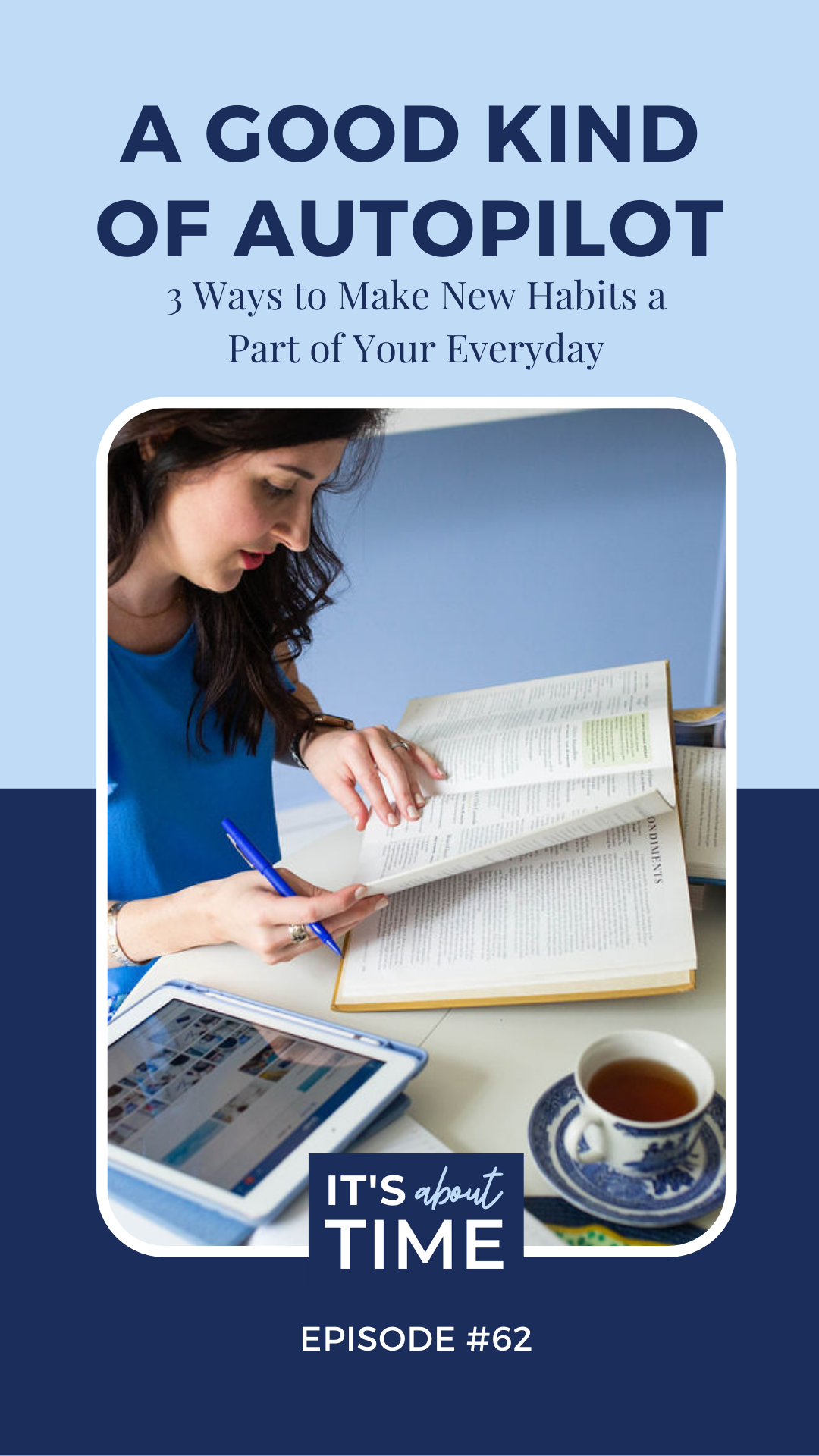
Have you ever heard the phrase “living life in default mode?” or what about “living on autopilot? “Going through the motions” even.
Most of the time, those descriptors have a pretty negative connotation. If you’re listening to this podcast, I know that you’re someone who wants a life that’s fulfilling and full of joy – not a life that’s gray and blah and boring. Right?
But here’s the thing. Sometimes autopilot can actually be a great thing in our lives!
Episode 62 of It’s About Time is all about habits.
Yep – those little bitty building blocks of our lives that have the ability do wondrous things for our health, wellbeing and success.
Although bad habits totally have the ability to wreck your life, in this episode, we’re keeping things positive and focusing on implementing good ones.
Whether you’re turning as this episode is released in January 2021, or you’re listening in as the leaves are turning in October – we’re always on the hunt for new, good habits.
Meal planning, exercising, waking up earlier, less screen time. The possibilities are endless. And while it’s super easy to come up with a whole laundry list of habits you’d like to add to your life, the tough part comes with making them a day-to-day reality.
Keep reading to find out:
-
Why putting yourself on autopilot with habits is a great thing
-
And The key to staying motivated when it comes to sticking with a habit
-
Then, I’m diving into Three ways that you can take your take your habits from ideas to action
-
Plus – one bonus tip you won’t want to miss
I’ve also got you covered if you haven’t had a chance to set your goals for the year ahead yet. If I’m going to be perfectly honest, as of today – I haven’t charted out my goals for the year yet either. Last year, I didn’t sit down and put pen to paper until around January 20th.
But I knew I had nothing to worry about because of my simple, 3-part system for getting it done and making things happen.
You can hear all about this simple technique for planning with purpose back in episode 59.
LISTEN NOW to EPISODE 59
Plan With Purpose: How to Plan Your Year with Intention Even in Times of Uncertainty
If you’re thinking – what’s the point? – It’s already January! – It’s never too late to set goals and create your intention for the year – and if you want a partner in the process, make sure you get your hands on my free 2021 Plan With Purpose Checklist bundle which includes my Plan to Plan checklist – everything I do to set myself up for success for planning my year ahead, including a supply list – plus you’ll find the 29 questions I ask myself each year to Plan with Purpose.
I’ve already heard from several of you who have started planning your year with the checklist, and I’m loving all of the photos shared on instagram of you putting up your calendars and setting up theme days.
Autopilot is a good thing?
When we think of living life on autopilot, we kind of picture someone going through the motions without a whole lot of zest for life, right?
At least – that’s what I picture. Wake up, get dressed, go to work, come home from work, heat up a Lean Cuisine, watch Netflix, scroll Instagram, go to bed, repeat.
Not a ton of variation or joy, definitely no zest or excitement.
It just sounds kind of grey… or beige.. Greige… and boring.
But – It’s possible to strike a balance between a full and fulfilling life and one that includes a healthy bit of autopilot – and you might already be living parts of your life on autopilot without realizing it – and that’s perfectly okay! A good thing, even!
It’s estimated that the average adult makes about 35 thousand remotely conscious decisions each day.
If you get 7 hours of sleep, that comes out to around 2000 decisions an hour.
Yeah… that’s a lot.
And this past year when the coronavirus flipped our lives upside down, we very suddenly found ourselves having to make WAY more decisions than usual about how to work, where to work, how to do virtual school and work from home with kids – not to mention remembering to have a mask or two on hand anytime you leave the house.
Raise your hand if you’ve ever had to do the walk of shame back to the car after forgetting your mask before walking into a building.
Forming new habits is hard, especially when they aren’t super fun and don’t naturally fit into our existing lifestyle.
Decision Fatigue
Cue the decision fatigue – the feeling we experience when we’ve made so many decisions in a single day that our decision making abilities get weaker and weaker… this is why so many bad decisions happen in the evenings, by the way. It’s a lot easier to stick to your diet in the morning than it is to avoid ice cream calling to you from the freezer after dinner.
Making something a habit is like putting yourself on autopilot, and you don’t waste precious, limited, decision making energy.
Author John C. Maxwell once said “Life is a matter of choices, and every choice you make makes you.”
So – obviously, you want to set yourself up to make the best choices you can, because your life depends on it. No pressure.
And when we take something that’s good, and enhances our life – like meal planning, less screen time or something similar – and make that a habit – that’s a good kind of autopilot that helps us put more effort and energy into that sparkly zest for life kind of living we want to do.
So now that we’re all on the same page about autopilot being a good thing when it comes to good habits, let’s zoom in on what a habit actually is.
The Building Blocks of a Habit
This makes me picture watching a video in science class a million years ago about atoms. How atoms are already super tiny building blocks of matter, but even atoms can be broken down into smaller parts.
And so it is with habits.
Habits can be broken down into three parts – the cue, the routine and the reward.
For more reading on habits, check out Charles Duhigg’s book The Power of Habit. He uses this three part breakdown of habits.
Another super popular book on habits is Atomic Habits by James Clear. In his book, Clear breaks habits down even further into four parts – the Cue, the Craving, the response and the Reward.
My 2021 word of the year is “simplify”, so I’m going to stick with Duhigg’s three part breakdown for this episode – but I wanted to give you a heads up that there are a few different schools of thought on the parts of a habit.
Anyway – habits can be broken down into three parts, the cue, the routine and the reward.
The Cue. The Routine. The Reward.
The cue is the thing that happens that makes you think of doing the habit.
The routine is doing the habit
And the reward is how you feel after you do the habit, or it could be an external reward. More on that later.
Since so many of you have reached out recently with questions about forming a meal planning habit, I’ll use meal planning as an example.
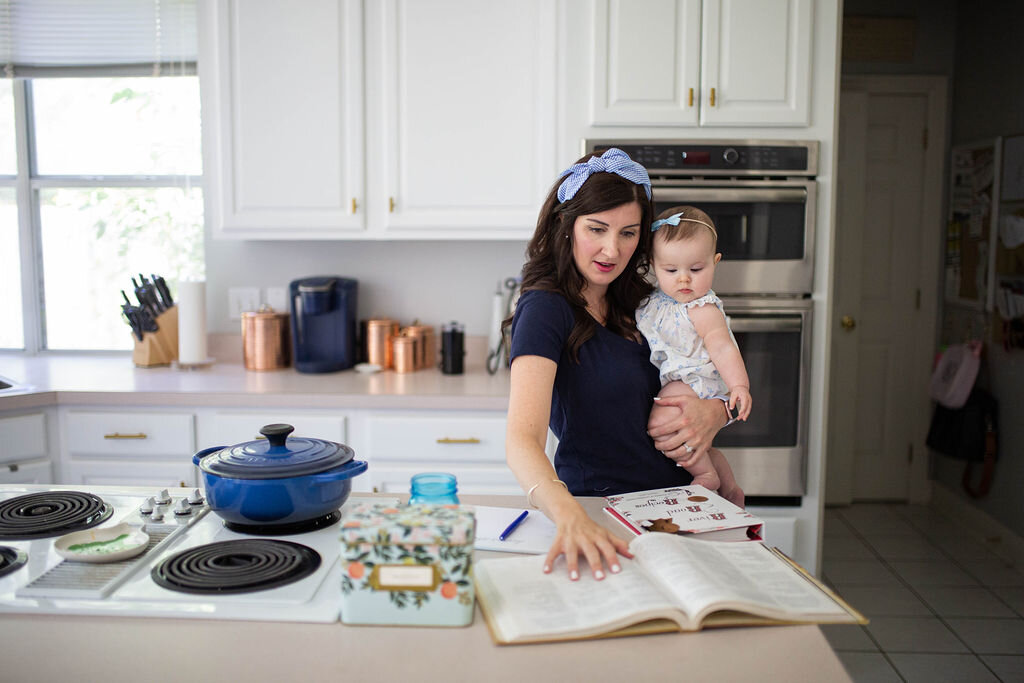
Photo Credit: Sarah Becker Photography
And if you’re not familiar with the life-changing concept of meal planning, it’s basically mapping out what you’ll eat for either the week ahead, or maybe even the month ahead, making your grocery list and then sticking to that plan. It makes life so much easier, because it eliminates that frantic, oh my gosh it’s 6:45 and I’m starving and we only have two eggs and a bottle of hot sauce in the fridge feeling.
So if the cue is the thing that happens that makes you think of doing the habit, for meal planning, that cue might be an alarm or a reminder that dings on your phone every Sunday morning reminding you to meal plan.
The routine is then sitting down to plan your meals.
The reward is the amazing feeling of satisfaction that comes with having your meals planned out, knowing you won’t stress out later in the week, hangry in front of an empty fridge.
Make sense?
Now that we’re experts on the building blocks of habits – let’s take a look at three ways that you can make good habits a part of everyday life.
Start with Why
But first… we’re going to start with why.
If you’ve listened to other episodes of It’s About Time, you might have heard me say a time or two before that your Why is the fire to get you started and the fuel to keep you going.
Anytime you set a goal, launch a business, start a new project, embark on a new endeavor and yes – build a new habit – you’ve got to get crystal clear on WHY you want to do that thing.
The thing is – without a clear reason, a deep why for doing what we do – it’s really easy to throw in the towel and give up when the going gets tough.
Common Reasons for Giving Up
Some common reasons for giving up on new, good habits?
Maybe the habit was more about meeting someone else’s expectation than something you actually really wanted.
Maybe the goal was more superficial than heart focused.
Maybe your why just wasn’t strong enough.
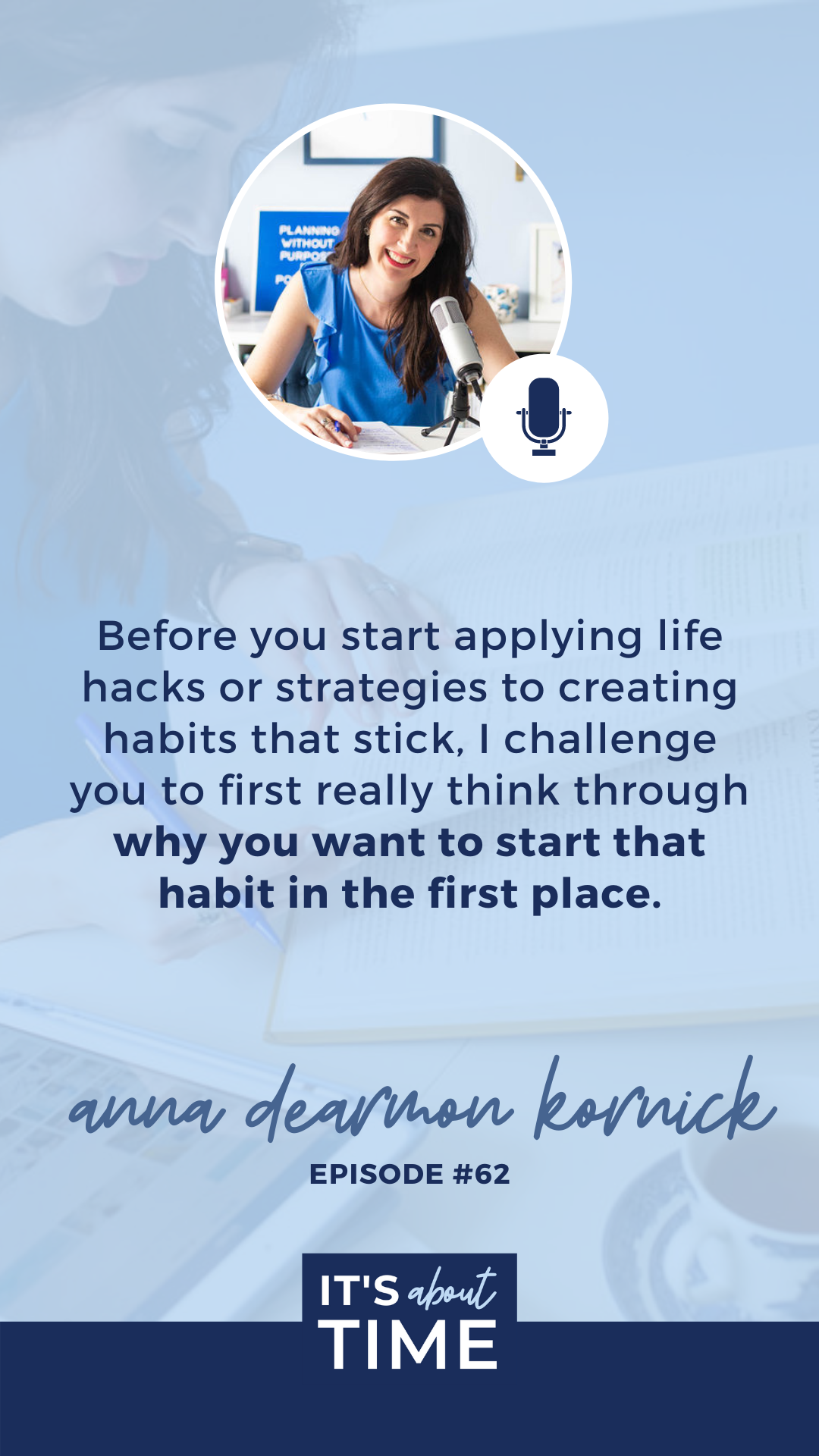
In the book, The Productivity Project, author Chris Bailey spent about a year test-driving all sorts of different productivity hacks, figuring out what actually works and what doesn’t. One thing he tried was getting up super early, 5AM I think – because he’d read that so many great, powerful, productive and successful people also work up at the crack of dawn. But – he hated it, and realized, that he didn’t need or want to get up at 5am. His scheduled allowed for writing and working later in the day, and waking up at 5am didn’t really match his energy. He recognized that he didn’t have a strong enough “why” beyond “well… other successful people do it?” so he stopped and didn’t look back.
So before you start applying life hacks or strategies to creating habits that stick, I challenge you to first really think through why you want to start that habit in the first place, and make sure it’s compelling enough to get you started and keep you going.
5 Whys
One way to really drill down into your why for starting a habit – or anything that’s new is to ask yourself Why 5 times.
Here’s the meal planning example again:
I want to start meal planning.
-
Why?
Because I want to know in advance what we’re having for dinner each night of the week.
2. Why do you want to know in advance?
Knowing in advance means I won’t be stressed out in the evenings.
3. Why do you want to be less stressed?
If I’m less stressed in the evenings about what’s for dinner, then I’ll be in a better mood around my family.
4. Why do you want to be in a better mood around your family?
If I’m in a better mood around my family in the evenings, we can actually have good conversations and spend quality time together before bedtime.
5. Why do you want to have good conversations and quality time?
Because my kids won’t be this age forever and I want to cherish these moments before they’re grown and gone.
BOOM.
That’s your why.
We just took forming the habit of meal planning to its deepest heart-level of why.
And chances are your 5 Whys will take you in a completely different direction – what’s important is that you ask the questions, know your why and keep it top of mind as you’re starting your new habit.
Even better? Let’s say that the example above with meal planning and wanting to cherish moments with your family is a perfect fit for you…
You could set an alarm or reminder on your phone to go off every Sunday morning that says “Meal Plan – Cherish the Little Moments” that not only serves as the Cue you need to start meal planning, but it snaps you straight to your why and keeps you going.
3 Ways to Make New Habits a Part of Your Everyday
Alright – so let’s take a look at those three ways that you can make your new habits a part of your every day.
01. Don’t just decide. Design.
First – don’t just start a new habit. Writing a habit down next to a row of checkboxes on a habit tracker isn’t going to just make it magically fit into your life.
Design your new habit. Really think through those three parts, the cue, the routine and the reward.
What will serve as your Cue for the habit? How will you remember to do it?
What exactly does it mean to go through the routine of the habit? Continuing the meal planning example – what will your meal planning process look like? Could you write out the steps? What does “complete” or “finished” look like?
Same thing with other habits like exercise or screen time – how can you be specific and actually determine what the habit – the action – actually looks like. It’s when we take habits from vague ideas to specific actions that we can actually follow through with them.
And finally – what’s the reward you’ll feel after you complete the habit.
With meal planning – if your 5Whys brought you to something like “Because my kids won’t be this age forever and I want to cherish these moments before they’re grown and gone” like in the example I gave, then your reward might be the satisfaction of knowing that you will be less stressed and therefore more present in the evenings. You’ll have that to look forward to.
But here’s the thing about starting new habits. Even when you carefully design them, they don’t always stick right away – and sometimes you don’t feel that internal satisfaction until you get into a good groove. But… you kind of need that satisfaction, that reward in order to get into the good groove. It kind of becomes a chicken and egg kind of thing.
How do I reward myself for sticking with the habit, if I don’t feel the reward until I stick with the habit?
Choose an External Reward
This, my friend, is where treats come in – or external rewards. Giving yourself an external reward for a while – until you really see the benefits and the internal reward kicks in – an external reward can be a great way to get into a habit groove.
For example – if you’re starting out with meal planning, give yourself a little reward like adding a candy bar to the grocery list or something else that gives you that feeling of accomplishment. Not all treats have to be food of course, and you could reward yourself in another way – but my mind usually goes straight to candy bars.
The pitfall to watch out for is that external rewards only last for so long – that’s why knowing that heart-focused why is so important to creating your long-lasting internal reward.
Ok – so if method number 1 is to design your habit with intention, method number 2 is to schedule your habit.
02. Schedule Your Habit
I’ve mentioned in the past that a few years ago I used this goal setting workbook with a page each month for writing down habits you want to create, and it had all of these little checkboxes next to where you’d write your habit.
So I’d optimistically write down my habits… and then never actually follow through with them. The disconnect was that writing them down next to checkboxes wasn’t enough – I actually had to find time for those habits on the pages of my calendar.
This is just another way that we can take the vague, aspirational idea of starting a good habit and actually take action.
When will you follow through on this habit? Does it match well with a specific time or day or day of the week? How can you find a home for this habit in the existing fabric and rhythm of your day?
Find it, put it in your calendar, set a reminder and follow through. This way, once it has a home on your calendar – whether that’s a digital calendar or a paper planner, you can see it, and you can see that you’ve created space for it in your day.
03. Pair Your New Habit with an Existing Habit
And finally – method three – pair it with an existing habit.
The research varies, but studies have shown that as much as 40 to 95% of our lives are based on habit. That means that there are already a lot of things in your life on autopilot.
So – if you’re trying to start a new habit and it doesn’t fit neatly into your schedule – find another habit and hijack it.
Pairing a new habit with an existing habit can help serve as a cue to remind you to do the new habit.
Example 01. Vitamins + Coffee Cups
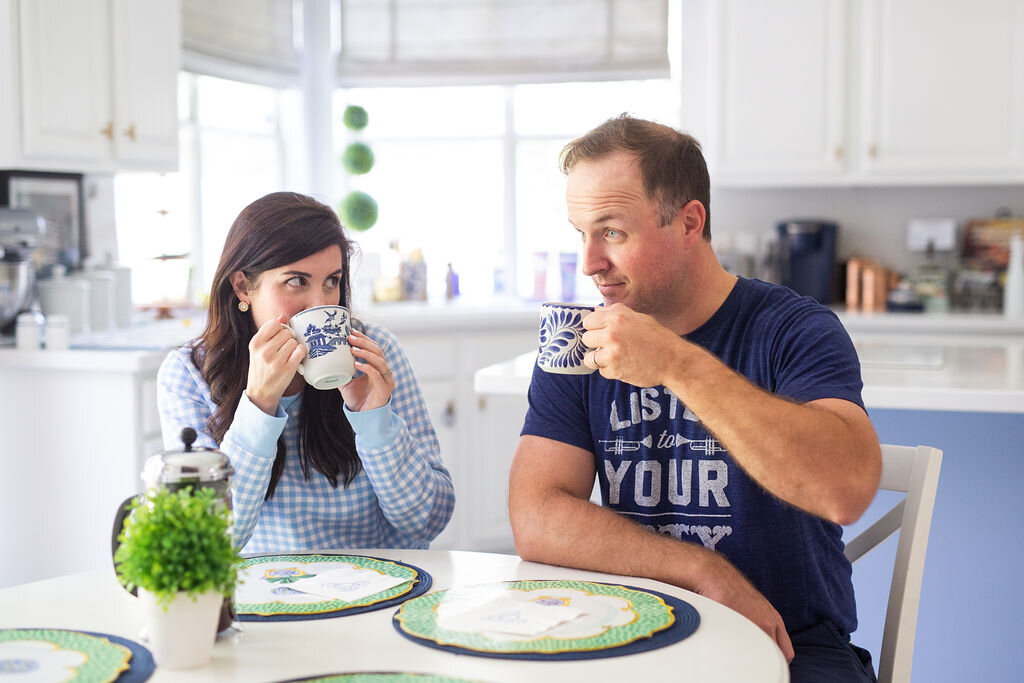
For example – I keep my vitamins in the cabinet with my coffee cups. The coffee is most certainly happening every morning, and seeing my vitamins right next to my cups reminds me to take them.
Think about the new habit you want to start, and think through your day – what existing habit could you pair with your new habit? And how can you set yourself up to remember the new habit?
Example 02. Stop Sign + Morning Prayer
Here’s an interesting example or habit pairing from one of my time management clients. One of my former one-on-one time management clients is a healthcare professional on the Covid front lines, who is also in graduate school. Needless to say, she has a lot on her plate.
She found that her days at work always went smoothly when she started with prayer, but in the hustle and bustle of getting out of the house and to the hospital, she didn’t always take the time to pray before walking into work.
So – we did a mental walkthrough of her morning, and together we realized that she always stopped at a stop sign at the end of her neighborhood before turning into traffic on her way to the hospital. That stop sign became her cue and her reminder to say a prayer before work.
Her internal reward was the peace she felt as she began her hectic and long days, but we also created an external reward. In the beginning, every morning that she stuck to her stop sign prayer habit, she rewarded herself with a special coffee from a nearby coffee truck. After a while, she stopped getting the coffee because she didn’t really need it anymore to make the habit a habit.
bonus tip: TIE THE HABIT TO YOUR IDENTITY
And finally – here’s that bonus tip I mentioned.
Tie the new habit you’re starting to your identity.
So what exactly does that mean?
We’ll turns out – even the way we think about and talk about our new habits impacts our ability to stick with them.
Instead of saying “I’m going to start meal planning.” change that up to “I am someone who meal plans.”
Maybe you’ve never meal planned a day in your life and your first meal planning sesh is scheduled for this coming Sunday – but By tying your habit – meal planning, to your identity – being someone who meal plans, then you’re going to be more likely to follow through when the time comes and to act in alignment with your identity.
Give it a try with your new habit:
I am someone who exercises three times a week.
I am someone who puts my phone away at 8PM.
Try it, tie your new habit to your identity, and see what happens.
To Recap:
Putting yourself on autopilot with good habits can be a really amazing way to enhance your life, cut back on decision fatigue and live better.
A habit is made up of three parts, the cue – the routine – and the reward.
Knowing your why – your heart-focused why for starting a new habit is the fire to get you started and the fuel to keep you going.
And three ways to make your new, good habits stick is
-
First: don’t just decide to start a habit, design it
-
Second: schedule it into your day or your week
-
And Third: pair it with an existing habit.
And that bonus tip – tie your new habit to your identity. Make it a part of who you are, and act accordingly.
JUMP START YOUR FRESH START
And if you want to jump start your new habits and 2021 goals with the help of a coach, I’m here for you.
Book a POWER HOUR Coaching Session
I’ve opened up a limited number of spots on my coaching calendar in January and February for one-on-one POWER HOUR coaching sessions. You, me and one hour to dive in and tackle your biggest time management challenge, or create that plan you need to stick to your resolutions and smash your goals in the new year. Plus, you’ll get unlimited accountability access to me for two full weeks after our power hour for when you need extra support and a sounding board. There are less than 10 of these power hour spots available, so be sure to book your power hour before all of the spots fill up.
I should also mention that this is our last chance to work together until at least June of 2021. I’m heading into maternity leave in March and am looking forward to spending some quality time with my family as we welcome our new little one and grow into being a family of four. So if you’re on the fence, c’mon – jump off and let’s do this together.
LINKS & RESOURCES MENTIONED IN THIS EPISODE
WORK WITH ME
FREE RESOURCES
READ
LISTEN
-
Episode 40: These 7 Habits Could Change Your Life
-
Episode 11: How to Start Habits that Stick and Kick the Bad Ones
JOIN
-
Join the It’s About Time Academy!

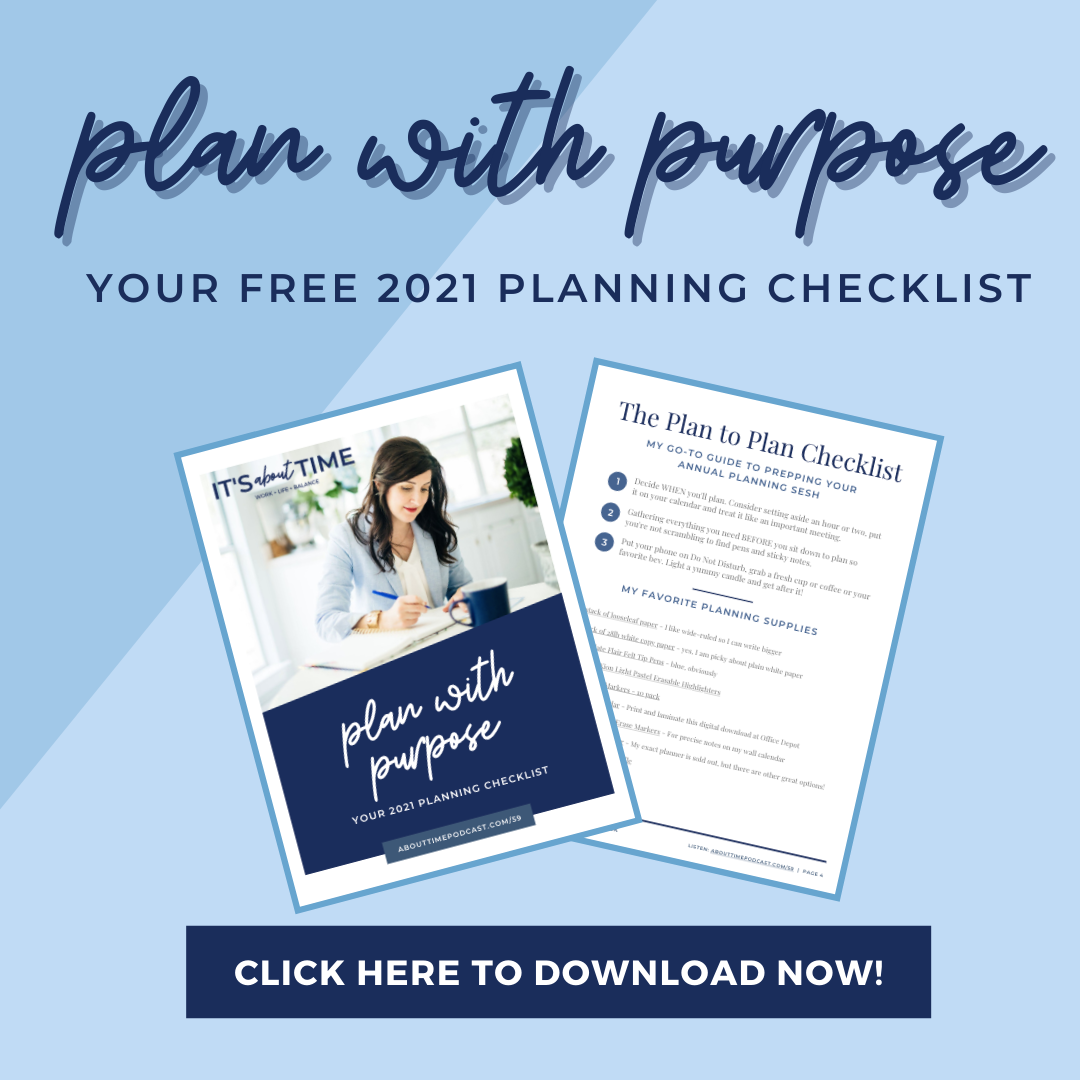

Be the first to comment